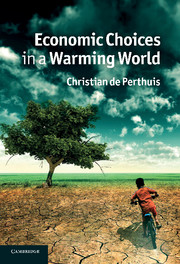Book contents
- Frontmatter
- Contents
- Acknowledgements
- Introduction
- 1 Climate risk
- 2 Some like it hot: adaptation to climate change
- 3 Building a low-carbon energy future
- 4 Pricing carbon: the economics of cap-and-trade
- 5 Intensifying agriculture to safeguard forests
- 6 The price of carbon: the economics of projects
- 7 Macroeconomic impacts: sharing carbon rent
- 8 International climate negotiations
- Conclusion
- References
- Appendix 1 Thirty key readings
- Appendix 2 Thirty key sets of figures
- Appendix 3 Greenhouse gas emissions around the world
- Glossary
- Index
5 - Intensifying agriculture to safeguard forests
Published online by Cambridge University Press: 05 June 2012
- Frontmatter
- Contents
- Acknowledgements
- Introduction
- 1 Climate risk
- 2 Some like it hot: adaptation to climate change
- 3 Building a low-carbon energy future
- 4 Pricing carbon: the economics of cap-and-trade
- 5 Intensifying agriculture to safeguard forests
- 6 The price of carbon: the economics of projects
- 7 Macroeconomic impacts: sharing carbon rent
- 8 International climate negotiations
- Conclusion
- References
- Appendix 1 Thirty key readings
- Appendix 2 Thirty key sets of figures
- Appendix 3 Greenhouse gas emissions around the world
- Glossary
- Index
Summary
Marjohan proudly displays a wad of cash, more than 800,000 Indonesian rupees in freshly printed notes. It's his first pay packet, which he will hand over to his mother. He has been taken on to work for a palm oil operation, 35 kilometres from his village, set up in the middle of the jungle. His job involves cutting down and then burning the trees of the tropical forest. Once the forest has been cleared, he hopes to find a permanent job on the new plantation, which would enable him to free himself from the family rice-growing business.
With Marjohan's wages, the family will be able to buy a motorbike. As well as helping them go back and forth to the nearby town Samarinda, he is also intending to use it to travel to work. At present he is dependent on the bus chartered by the Australian plantation manager, which does the return journey once a week. He hopes to have a little more freedom of movement once the family motorcycle has been acquired.
If we include the emissions produced by Marjohan's new job in the national inventory of Indonesian emissions, the picture is completely different. For each hectare of forest cleared, the combustion of the wood burned on the spot emits around 600 tonnes of carbon dioxide (CO2) into the atmosphere. When the forest has grown in a damp environment such as a peat bog, the soil has to be drained before planting palm trees for the plantation.
- Type
- Chapter
- Information
- Economic Choices in a Warming World , pp. 117 - 145Publisher: Cambridge University PressPrint publication year: 2011



